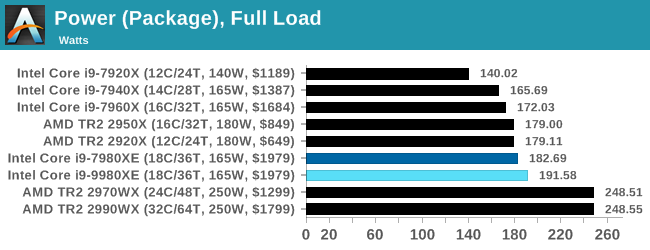The Intel Core i9-9980XE CPU Review: Refresh Until it Hertz
by Ian Cutress on November 13, 2018 9:00 AM ESTPower Consumption
One of the key topics in power consumption recently has been whether Intel’s approach to power, or to how it represents its Thermal Design Power (TDP) values, is valid or not. Intel’s take on TDP is that it should represent the sustained power of the processor, which unfortunately does not take into account any of the turbo modes available to the users (or disclose how long those turbo modes should be available for). Part of this is not only confusing, but motherboard manufacturers rarely use Intel specifications for these limits anyway, as you can read in our article covering the practice here.
With the Core i9-9980XE, the typical representation of power is used: stick to the turbo tables unless the system is thermally compromised. In this case the 165W TDP value is a guide, not a limit or a suggestion – it relies on the quality of the silicon and the ability of the motherboard manufacturer to be stable, performance focused, and competitive.
Comparing the Core i9-9980XE to the Core i9-7980XE, the new processor has a higher base frequency by 400 MHz, a higher single core turbo frequency by 100 MHz, and a higher all-core turbo, but uses a newer 14++ manufacturing process and soldered thermal interface material. The peak power consumption numbers are as follows:

Looking at the full chip values, the peak power consumption we observed for the Core i9-9980XE is 192W. This is 9-10W higher than our Core i9-7980XE sample.
If we remove the ‘idle’ power numbers away to see the core-only power, then the Core i9-9980XE uses around 152W just for the cores, which should be around 8.5W per core. The 32-core Threadripper 2990WX by contrast uses around 6W per core.
If we look at the efficiency of each processor, with our power numbers taken during a POV-Ray run:
The Core i9-7980XE gets a performance per watt of 43.3 POV-Ray points per watt - the new Core i9-9980XE scores a little less at 42.7, as for the extra 5% of power, we get a 3.6% increase in performance. For competition, the only HEDT processors coming close are the other Intel HEDT parts, or the 2990WX at the top right of the diagram. Obviously, this is benchmark specific, but an interesting comparison nonetheless.











143 Comments
View All Comments
coder543 - Tuesday, November 13, 2018 - link
I think you mean that Inte's 1 or 2 cores often beat AMD's 1 or 2 cores. In benchmarks that are highly multithreaded, AMD beats Intel. Intel currently has a frequency advantage, so they win in the lightly threaded tests.coder543 - Tuesday, November 13, 2018 - link
Intel's*AnandTech and Twitter both need an edit button.
HStewart - Tuesday, November 13, 2018 - link
But my question in real life do you need this many core - I still think it better to have single thread core speed. I say that even as developer that uses multiple threads.GreenReaper - Wednesday, November 14, 2018 - link
Depends on what your real life is, doesn't it? That's why reviews don't have one benchmark and the final paragraph of the conclusion here emphasizes that the right processor for you depends on your workload, even *without* considering the relative prices. For many workloads none of the CPUs tested here are appropriate; a 2400G would be the most efficient, cost-effective option.twtech - Thursday, November 15, 2018 - link
Yes. I could use about twice this many. I also need good single-core clockspeed as well. That's why I'm eagerly anticipating the 3175x launch.bji - Tuesday, November 13, 2018 - link
Windows is garbage. Put these chips onto a real operating system (Linux) and you will see the actual performance they are capable of without Windows holding them back. See Phoronix.twtech - Thursday, November 15, 2018 - link
It's nice if you have that option. Most of the time the software you run only works on certain operating systems and you don't have much choice.Lolimaster - Thursday, November 15, 2018 - link
In benchmarks where the 2950X at 1K will score similar too? What's the point?AMD top dogs are on another whole level, if you got the workload for them, take them, else 2950X.
Arbie - Tuesday, November 13, 2018 - link
Typo - you wrote "Intel will need to up its game here to remain competitive". Should have been "Intel will need to up its marketing here to remain competitive".eva02langley - Tuesday, November 13, 2018 - link
Unfortunately, they are selling everything. I would be happy if they were not selling anything.